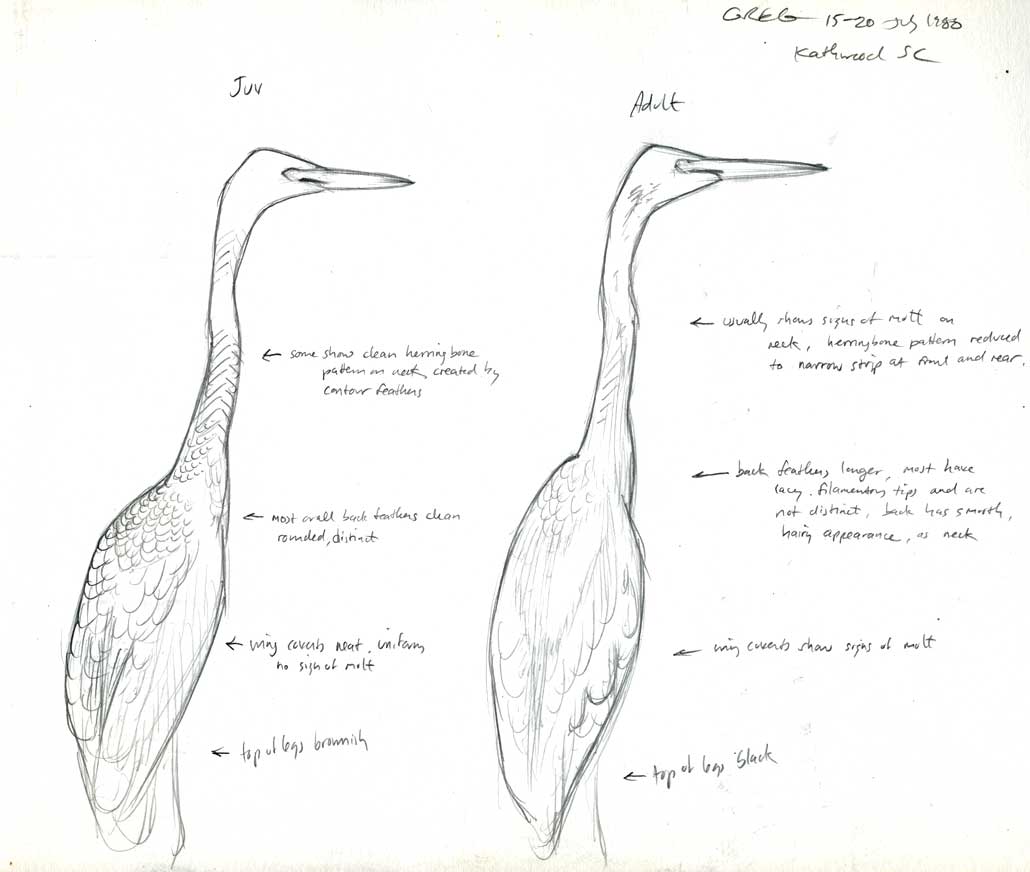
Identifying the white herons and egrets can be a challenge. We must rely mainly on structure, behavior, and the color of bare parts like bill and legs, because plumage offers very little in the way of field marks. One aspect of plumage can be very helpful, however. By looking at the shape and condition of the feathers, and the patterns created by groups of feathers, it is often possible to distinguish fresh juvenile birds from older individuals, even when the feathers are all white. Knowing the age of a bird is interesting on its own, and it can lead to a more precise assessment of other features, which is helpful for identification.
This distinction relies on the basic fact that adults molt in late summer and show a mixture of old and new feathers – a patchwork of feathers at all stages of growth – while, at the same time, recently-fledged juveniles have pristine plumage with all feathers new and all the same age. The uniformly new plumage of juveniles, combined with small differences in feather shape (usually shorter and narrower on juveniles) can lead to subtle but distinct differences in appearance that will allow you to age many birds.
The sketch and this discussion focuses on birds that are standing, but molting flight feathers are very obvious in flight. This is a reliable and simple clue for age, since juveniles do not molt the primaries and secondaries until they are about a year old. The same pattern of molt timing applies to many other species of birds, so (while this is written specifically about Great Egret) the basic concepts described below can be applied across a broad range of species.
Great Egret: Juveniles vs adults
- Juveniles in fresh plumage show a very even and smooth “herring-bone” pattern on the neck created by the alignment of thousands of perfectly matched tiny feathers (vs adults usually show signs of molt on neck, with small gaps where feathers are missing; they can show the “herring-bone” pattern but only faintly on the back of the neck.)
- Juveniles have virtually all of the back and scapular feathers short and rounded, with edges distinct and forming a smooth and regular scaled pattern (vs adults have most of the back feathers longer and tapered to a point, which gives the whole back a silky/hairy texture rather than scaly)
- Juveniles have all wing coverts neatly aligned and uniform, all the same age with no signs of molt (vs adults show obvious gaps and irregularities in the wing coverts where feathers are worn, damaged, and/or molting)
- Juveniles lack the very long plumes on the back (vs adults have very long lacy scapular plumes, extending to the tip of the tail and with the tips often stained slightly orange by late summer)
There are no reliable differences in bill color or eye color that help to age Great Egrets, but juveniles do tend to show paler brownish color at the top of the legs (vs blackish on adults)
These are all small and subtle differences, and they require a close view and the right lighting to show feather contours, but together they form an overall impression that is distinctive. Practice by looking for these differences when birds are close, and soon you will be able to distinguish adult and juvenile egrets at greater and greater distances.


Having a difficult time determining if it is an Egret or a Heron
The Great Blue is obvious the lesser Blue is not.
Pingback: Where Do Black-crowned Night Herons Live? – Ploverbirds.com